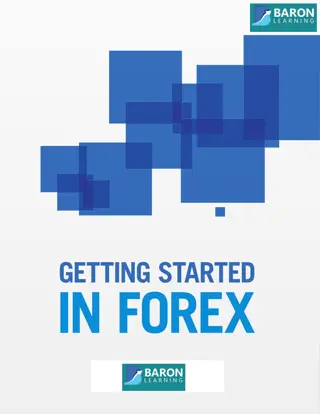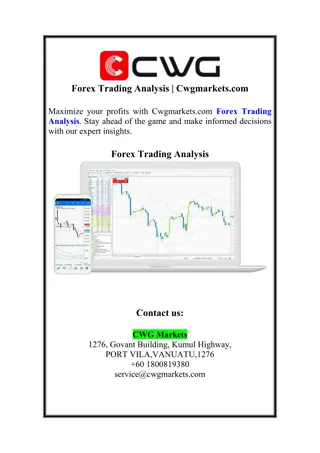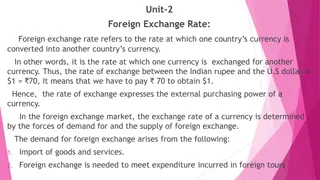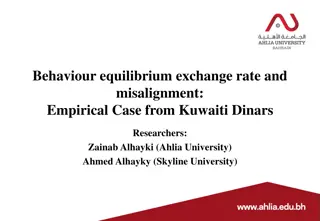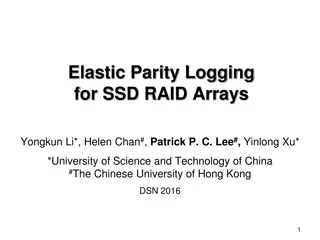Understanding Forex Parity Relationships and Forecasting Exchange Rates
Discover the intricacies of interest rate parity, purchasing power parity, Fisher effects, and alternative theories in forecasting exchange rates. Delve into examples illustrating covered interest arbitrage and currency carry trade strategies. Explore how these concepts impact the FX market and learn insights on leveraging opportunities for profit.
Download Presentation

Please find below an Image/Link to download the presentation.
The content on the website is provided AS IS for your information and personal use only. It may not be sold, licensed, or shared on other websites without obtaining consent from the author. Download presentation by click this link. If you encounter any issues during the download, it is possible that the publisher has removed the file from their server.
E N D
Presentation Transcript
Parity Relationships: Forecasting FX Rate
Sections Interest rate parity Purchasing power parity Fisher effects Alternative theories Forecasting exchange rates
Interest rate parity (IRP) IRP: the forward premium/discount is equal (close) to the interest rate differential. IRP is an arbitrage condition. If this condition is violated, arbitrage opportunity arises. In American terms, (F S) / S = (iD iF) / (1 + iD) iD iF In European terms, (F S) / S = (iF iD) / (1 + iD) iF iD Interest rate: i; domestic: D; foreign: F.
Example Suppose that spot $/ = 1.80, the 1-year forward $/ = 1.78, i = 8%, and i$= 5%. Because quotations are in American terms, we use the following equation: (F S) / S iD iF The forward premium/discount is (1.78 -1.80) / 1.80 = - 1.11%. The interest rate differential is 5% - 8% = -3%. -1.11% -3%. Arbitrage opportunity arises.
Covered interest arbitrage Spot $/ = 1.80, the 1-year forward $/ = 1.78, i = 8%, and i$= 5%. Sequence of transactions: (1) Borrow $1. Repayment of the loan in one year will be $1.05. (2) Convert $1 today into 0.555556 (= 1/1.8). (3) Save 0.555556 in the U.K and grow it to 0.6 (= 0.555556 1.08). (4) Sell (short) 1-year 0.6 forward today in exchange for $1.068 (= 0.6 1.78) in a year. The arbitrage profit is $0.018 (= 1.068 1.05). Note that no equity and no risk.
Currency carry trade Currency carry trade involves buying a currency that has a high rate of interest and funding the purchase by borrowing in a currency with low rates of interest, without any hedging. The carry trade is profitable as long as the interest rate differential is greater than the appreciation of the funding currency against the investment currency.
Example Suppose the 1-year borrowing rate in dollars is 1%. The 1-year lending/saving rate in pounds is 2 %. The spot ask price is $1.60/ . A trader who borrows $1 will owe $1.01 in one year. Trading $1 for pounds today at the spot generates 0.625 (= 1/1.6). ( = $ x /$) 0.625 invested for one year at 2 % yields 0.640625. The currency carry trade will be profitable if the spot bid rate prevailing in one year is high enough (> $1.5766/ ) that his 0.640625 will sell for at least $1.01 (enough to repay his debt).
China carry trade Looking for carry trade? Yuan ranks among the best. The dollar is heading for a fifth month of losses. Meanwhile, China s relative yields over dollar assets and foreign inflows are all supportive of further gains for the yuan. As of 08/28/2020, China 10Y government bond yield is about 3.1%. US 10Y T-bond yield is about 0.74%. Source: Bloomberg, 08/2020
Yen as a safe-heaven currency In a carry trade, investors will borrow money in a low-interest rate environment and then invest that money in higher yielding assets from other countries. Japan s long-standing policy of near-zero interest rates has caused it to become a major source of capital for these types of trades. When uncertainty hits global markets, it can cause investors to unwind these trades, which then results in additional demand for the yen, leading to yen appreciation. (Bloomberg, 08/2019) -- Stocks tumbled and bonds and the yen jumped in the wake of President Donald Trump s move to escalate the trade war, with China pledging countermeasures if the U.S. steps up tariffs on its goods. Source: financialsense.com.
IRP logic: the law of one price Consider S( /$) = 100, i$ = 3%, i = 1%. $1 saving in the U.S. generates $1.03 payoff in a year. $1 saving in Japan generates 101 (= 100 1.01) payoff in a year. The law of one price: the price/payoff of $1 needs to be the same regardless of whether staying in the US or detouring to Japan. The correct forward rate should be F( /$) = 98.06 (= 101/1.03). IRP: (98.06-100)/100 1% - 3%.
Reasons for deviations from IRP Although IRP tends to hold quite well (thus, IRP is used for pricing forward contracts), it may not be precise for two reasons: (1) Transactions costs The interest rate available to an arbitrageur for borrowing may exceed the rate he can lend at. There are bid-ask spreads to overcome. (2) Capital controls Governments sometimes restrict import and export of money through taxes or outright bans.
Uncovered interest rate parity Recall In American terms, (F S) / S iD iF. If one believes forward rate is a good estimate of future spot rate and replaces F with SN (the spot rate in N months), the LHS of the equation becomes the expected rate of change in the exchange rate, E(e). That is, E(e) iD iF. This relationship is known as the uncovered interest rate parity.
IRP and exchange rate determination Recall in European terms, (F S) / S iF iD. Relative interest rates drive spot rate. All else equal, an increase in the U.S. interest rate will leads to $ appreciation. Consider S( /$) = 100, i$ = 3%, i = 1%. If i$ goes up to 4%, it will takes less than $1 today (that is, $0.9934 = 1.03/1.04) to grow to $1.03 in a year. Thus, $ has a higher purchasing power @ i$ = 4%. Higher iD higher S (a stronger dollar and a higher purchasing power today). Alternative logic: higher interest rate in the U.S. attracts capital to the U.S. higher demand and value for $. Forward rate also plays a role in shaping spot rate. It signal today s market expectation.
2008 financial crisis The Federal Reserve s unconventional efforts to ease monetary policy by buying large amounts of long-term securities weakens the dollar in the same way that conventional interest-rate cuts do, a (San Francisco Fed) study released Monday showed. "We find that a quantitative easing surprise equivalent to a 1 percentage-point decrease in federal funds rate futures leads to a 0.5 percentage-point depreciation in the dollar." A cheaper dollar can boost the U.S. economy by making it easier to sell U.S. goods to other countries. Source: CNBC, 04/01/2013
Pandemic and US dollar The U.S. dollar on Thursday plunged to a more than 2.5-year low against a basket of its peers after the Federal Reserve pledged to keep interest rates low until the economy shows signs of a sustainable recovery. A weaker dollar makes American-made products cheaper for overseas buyers, but also makes imports more expensive for U.S. consumers. Source: Fox Business
Raising interest rate On December 17, 2015, the Fed raised its rates. As expected, the dollar is on the up. The pound is down 0.44pc to $1.4939, while the euro dropped to $1.0852, having fallen as low as $1.0832 from $1.1000 in the wake of the Fed's statement. The dollar also advanced to 122.40 yen. Source: The Telegraph.
Abenomics Abe came to power at the end of 2012 with a three part economic plan: fiscal stimulus, deregulation and the BOJ monetary plan (QE). depreciated from 80/$ to 120/$ in the following 2 years. QE isn t quite working, said a hedge fund manager. What did Abenomics accomplish? Economic growth certainly hasn t shown any improvement. The depreciation of the yen is fundamentally a very successful policy, said another local investor Many financial market participants do not fully acknowledge the changes that have taken place in Japan. Tourism is booming. Overseas investor interest in Japanese real estate has picked up. Wages are rising. Source: The Japan Times, 04/01/2015
PPP and exchange rate determination Purchasing power parity (PPP) is the result when the law of one price is applied internationally. Absolute PPP: the spot rate between currencies of two countries should be equal to the ratio of the countries price levels. S = PD / PF. If the standard commodity basket costs $225 in the U.S. and 150 in the U.K., the spot rate should be $1.5 per pound: $1.5/ = $225/ 150. Implication: if we suddenly experience inflation in the U.S. and the standard commodity basket costs $250. The spot rate becomes $1.6667/ (= 250/150). Thus, $ depreciates.
Problems with absolute PPP Assumptions (no trading cost and no impediments) are too strong. Exchange rate is a macroeconomic variable, while it is difficult to calculate an aggregate price for each country. Because of these fundamental problems, economists are more interested in the relative PPP in which all variables are measurable.
Relative PPP In American terms, e = (SN S) / S = ( D F) / (1+ F) D F, where is inflation rate. In expectational form, E(e) E( D) E( F). Example: the inflation rate is expected to be 6% per year in the U.S. The inflation rate in the U.K. is expected to be 4%. E(e) 2%. In American terms ($/ ), this means that the pound should appreciate against the dollar by about 2% in this coming year. That is, if today s spot rate is $1.5/ , we should expect the spot rate in a year to be about $1.53/ (= 1.5 1.02). Logic: higher inflation in the U.S. $ has lower purchasing power $ depreciates.
Hyperinflation Venezuelan currency tanks; inflation seen near 100%. The unofficial exchange rate for the bolivar has fallen sharply in recent weeks, so that on Thursday, one dollar would get you 300.72 bolivars. In 2012, a dollar would get you 10 bolivars, according to unofficial exchange rates. By the time President Nicolas Maduro was inaugurated in April 2013, it was 24 bolivars to the dollar and by this January it was at 173. Source: CNBC, 2016
Pesos death spiral A sharp selloff of the Argentine peso is sparking new inflation fears in South America s second- largest economy. For a country that is heavily dependent on foreign capital and has a history of repeatedly destroying its currency, this is no passing storm. Source: WSJ, 05/13/2018
Overheated economy + inflation + currency depreciation Turkey's central bank vowed to take action after inflation hit its highest pace in 15 years, fueling expectations that it will raise interest rates next week, but analysts questioned how far the institution could defy President Recep Tayyip Erdogan's prescription of lending on the cheap. Turkish annual consumer-price inflation hit 17.9%, up from July's reading of 15.9%. The Turkish economy had a stunning run last year, expanding 7.4%. The lira has lost more than 40% this year. Source: MarketWatch, 09/04/2018
Real exchange rate Real exchange rate, q, measures deviations from PPP. In American terms, q = (1+ D) / [(1 + e) (1 + F)]. If PPP holds, q has a value of 1. If q < 1, domestic currency is underpriced (depreciated too much) easier for domestic industries to export. If q > 1, domestic currency is overpriced (appreciated too much) harder for domestic industries to export. Note that the values plotted in the next figure are index values (2005 = 100); these values are not real exchange rates; they are real effective exchange rates.
Real effective exchange rate (index, 2005 = 100)
Evidence on PPP PPP doesn t hold well in the real world; evidently, the previous figure shows persistent drifts. Shipping costs, as well as tariffs and quotas, can lead to deviations from PPP. PPP, nevertheless, provides a benchmark in determining whether a country s currency is underpriced or overpriced; just do not expect that this will be corrected any time soon (i.e., persistent drifts).
Fisher effects Fisher effects: an increase (decrease) in the expected rate of inflation will cause a proportionate increase (decrease) in the interest rate in the country. 1 + iD = (1 + rD ) ( 1+ E( D)), where i is the nominal interest rate, r is the real interest rate.
Real interest rate assumption If the Fisher effect holds in the U.S., 1 + i$ = (1 + r$ ) (1+ E( $)) and the Fisher effect holds in Japan, 1 + i = (1 + r ) (1 + E( )) and if the real rates are the same in each country, r$ = r then we have the following: 1 + E( )) 1 + E( $)) 1 + i = 1 + i$
International Fisher Effect (IFE) 1 + i$ = (1 + r$ ) (1+ E( $)) 1 + i = (1 + r ) (1 + E( )) r$ = r We also have E( $)- E( ) = i$ -i Substitute the above into the expectational version of the relative PPP: in American terms, e D F, we then have the IFE: E(e)( E( $)- E( )) i$ -i
P. 168 5. In the issue of October 23, 1999, the Economist reports that the interest rate per annum is 5.93% in the United States and 70.0% in Turkey. Why do you think the interest rate is so high in Turkey? Based on the reported interest rates, how would you predict the change of the exchange rate between the U.S. dollar and the Turkish lira? Solution: A high Turkish interest rate must reflect a high expected inflation in Turkey. According to international Fisher effect (IFE), we have E(e) = i$ - iLira = 5.93% - 70.0% = -64.07% The Turkish lira thus is expected to depreciate against the U.S. dollar by about 64%.
Alternative theories: Asset market approach This approach relates the value of currency to the country s economic growth and strength. Logic: robust domestic growth higher returns on domestic assets attract foreign investors higher demand for the country s currency stronger currency. The Balassa-Samuelson hypothesis makes similar prediction.
Assignment #1 Please perform an online research on Indian economy, apply the asset market approach to Indian Rupee (INR, ), and prepare a 1-2 page report on your prediction of INR for the next 1-5 years. Submit your report (individual assignment) in a week.
Trade war between US and China? The Dollar/Yen (in Japanese terms) declined last week as a sharp break in U.S. equity markets sent investors into the safety of the Japanese currency. The Forex pair reached its lowest level since the week-ending November 11, 2016. President Donald Trump signed an executive memorandum on March 22 that would impose retaliatory tariffs on up to $60 billion in Chinese imports. The dollar weakened on the fear that China is likely to retaliate against the tariffs by targeting U.S. agricultural products that are reliant on the Chinese export market. Source: Yahoo!Finance, 03/36/2018. Why?
Alternative view: Roles and value of a usable currency The traditional roles of a currency: (1) a medium of exchange, (2) a unit of measurement, and (3) a store of value. The CIO of Goldman Sachs, Sharmin Mossavar-Rahamani: "We expect further declines in the future given our view that these cryptocurrencies do not fulfill any of the three traditional roles of a currency: they are neither a medium of exchange, nor a unit of measurement, nor a store of value. (Business Insider, 08/06/2018)
Digital Yuan? Known as DCEP (digital currency electronic payment), it s experimented in several big Chinese cities, and is expected to be a digital ledger that will replace China s paper RMB currency. Digital Yuan is a digital currency, and not a cryptocurrency. PBOC is able to exercise granular control on user accounts and target behavior to very personalized segments. Digital Yuan cannot be converted to gold, nor foreign currencies. Source: 08/27/2020, Forbes Q: Trust? A medium of exchange? Liquidity?
Forecasting exchange rates: Efficient markets approach EMH: prices instantaneously and fully reflect all available and relevant information. If this is true, exchange rates will only change when new information arrives, thus: E[St+1] = St and E[St+1| It] = Ft EMH approach: using either the current spot rate or the current forward rate as a predictor for future exchange rate. A good approach? Debatable.
Forecasting exchange rates: Fundamental approach Involves econometrics to develop models that use a variety of explanatory variables. This involves three steps: Step 1: Estimate the structural model. Step 2: Estimate future parameter values. Step 3: Use the model to develop forecasts. The variables may include (1) relative inflation rates, (2) relative interest rates, (3) national income growth, (4) changes in money supply, etc. The downside is that fundamental models do not work any better than the forward rate model or the EMH approach.
Forecasting exchange rates: Technical approach Technical analysis looks for patterns in the past behavior of exchange rates. It is based upon the premise that history repeats itself. The approach is against the EMH. Technical technique is widely used (Taylor and Allen, 1992, JIMF). Many trade books on this (amazon.com).
End-of-chapter Questions: 1-8, 10, 11. Problems: 1-3, 5-7, 9, 12.



